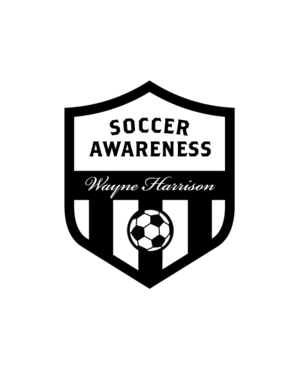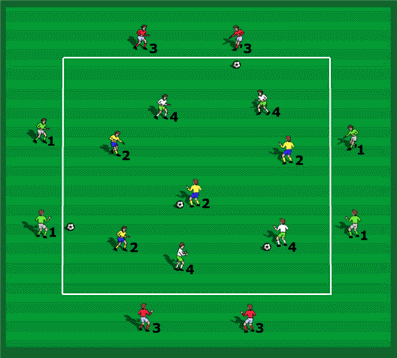Directional Awareness Four Team Passing Game - Training Center Exclusive
/Objective:
Awareness of Teammates and Opponents Positioning on the Field in Advance of Receiving the Ball
Coaching Points:
When and where to pass (timing, accuracy, weight)
Looking before receiving
Awareness of player positions before receiving the ball
Awareness of options on the ball before receiving it
Awareness of Opponents positions before receiving the pass
Maintaining possession of the ball
Rules:
Warm Up:
Two balls per inside team (or more). (2)’s pass to (1)’s and (4)’s pass to (3)’s. The two groups work across each other. Four teams working but in pairs.
Directional session now working across each other, needing to know where their teammates are but also where the other numbered players are in the middle. This improves awareness and the peripheral vision of the players.
A good lead in to everyone being free in the area and passing and moving later.
Players need to look before they receive, see what the options are in advance of the ball.
Progressions:
Passing in straight and / or angled lines
Running in straight and / or angled lines
Mixing the two up
Players pass to the end players only, to begin transferring the ball from one side to the other. If both players on the other side have balls at their feet then liken it in a game to the strikers being marked and you have pressure on the ball preventing a forward pass so you have to go back to where you came from, either to the other player you did not receive the pass from or back to the same player.
Passing inside the area to team mates in the buildup not just to the outside players.
Introduce give and go’s with outside players (players then keep the same ball throughout a set time period)
Switching positions with the outside
Passing inside the area first then outside
Outside players can pass to each other on the same side the ball moving and keep the inside players alert as to where the ball is.
Outside players switch positions with and without a ball, if without the ball then they are now moving targets as it would be in a game.
All players communicate with each other to help make each movement and pass successful (above as (4) receives the pass, (3) calls to let him know they are free to receive the next pass.
Ask inside and outside players to pass to space to move players into better positions to receive the pass.
Liken To Working Through The Thirds Of The Field (Defender To Midfielder To Striker And Back)
Above; (2) passes to space to move outside player (1) to receive. (3) Passes to space to move (4) into the path of the pass. (4) And (1) respectively can help (2) and (3) by pointing to where they want the ball if they identify the space to pass it to first.
Where is the space to take my next touch (if it open it could be towards the player they are about to pass to), or can I pass it one touch to (3) on the other side?
Already as this pass is coming in to (3) another (4) player is looking to support the next pass going back.
Competitive: The Game Situation
One ball only. Now we take the session into a game. (2)’s play against (4)’s. It is a 4 v 4 game.
(2) work with (1)’s on the outside and score by completing a pass to the outside players. They then have to get the ball to the other side to score again. (4)’s work with the (3)’s on the outside so teams play in opposite directions. Play to 10 goals then rotate the players so the (1)’s play against the (3)’s. Rotate the teams so the (1)’s play against the (2)’s and the (3)’s against the (4)’s. Here the number (4) team have scored one goal at one end then switched the play to the other end by quick accurate passing to score another goal.
The set up is designed to make it easier to maintain possession because they are going both ways and it is much more difficult to defend against. Players who give the ball away cheaply get punished because of this as it may be a while before they can win it back due to the set up so everyone has to stay focused.
Outside player’s one touch, inside players two or three touch restriction. This forces players to use their awareness to be successful. Outside player has only one touch so as the ball is traveling to them the inside players know this and need to get in position to support early. Player passing to the outside player knows they only have one touch so the weight of the pass must be right.
Progression: To score the player passing to the outside player cannot be the player to receive it back immediately. If they do they maintain possession but it is not a goal. This means at least one other player MUST get into a support position to help the outside players pass (and score a goal).
Progression: the first outside player receiving has to pass to the second outside player, then the inside players have to position and work an angle of support off of the 2nd player.















